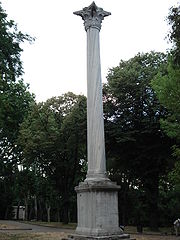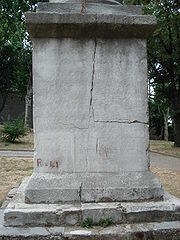
Column of the Goths
Encyclopedia


Gülhane Park
Gülhane Park is a historical urban park in the Eminönü district of Istanbul, Turkey, located adjacent to and on the grounds of the Topkapı Palace; the south entrance of the park sports one of the larger gates of the palace...
, Istanbul
Istanbul
Istanbul , historically known as Byzantium and Constantinople , is the largest city of Turkey. Istanbul metropolitan province had 13.26 million people living in it as of December, 2010, which is 18% of Turkey's population and the 3rd largest metropolitan area in Europe after London and...
, Turkey
Turkey
Turkey , known officially as the Republic of Turkey , is a Eurasian country located in Western Asia and in East Thrace in Southeastern Europe...
.
History
The name of the 18.5 metre high free-standing Proconnesian marbleMarble
Marble is a metamorphic rock composed of recrystallized carbonate minerals, most commonly calcite or dolomite.Geologists use the term "marble" to refer to metamorphosed limestone; however stonemasons use the term more broadly to encompass unmetamorphosed limestone.Marble is commonly used for...
pillar which is surmounted with a Corinthian capital derives from a Latin
Latin
Latin is an Italic language originally spoken in Latium and Ancient Rome. It, along with most European languages, is a descendant of the ancient Proto-Indo-European language. Although it is considered a dead language, a number of scholars and members of the Christian clergy speak it fluently, and...
inscription at its base, commemorating a Roman victory over the invading Goths
Goths
The Goths were an East Germanic tribe of Scandinavian origin whose two branches, the Visigoths and the Ostrogoths, played an important role in the fall of the Roman Empire and the emergence of Medieval Europe....
: FORTUNAE REDUCI OB DEVICTUS GOTHOS ("To Fortuna
Fortuna
Fortuna can mean:*Fortuna, the Roman goddess of luck -Geographical:*19 Fortuna, asteroid*Fortuna, California, town located on the north coast of California*Fortuna, United States Virgin Islands...
, who returns by reason of victory over the Goths"), which has been shown to have replaced an earlier Latin inscription. The dating and original dedication of the column are uncertain.
Most likely, the column was erected to honor the victories of either Claudius II Gothicus (r. 268-270) or Constantine the Great (r. 306-337), both of whom are noted for achieving victories over the Goths. According to Byzantine historian Nicephorus Gregoras
Nicephorus Gregoras
Nikephoros Gregoras, latinized as Nicephorus Gregoras , Byzantine astronomer, historian, man of learning and religious controversialist, was born at Heraclea Pontica....
(c. 1295-1360), the column was once surmounted by a statue to Byzas
Byzas
In Greek legend, Byzas was the eponymous founder of Byzantium , the city later known as Constantinople and Istanbul.-Founding of Byzantium:...
the Megarian
Megara
Megara is an ancient city in Attica, Greece. It lies in the northern section of the Isthmus of Corinth opposite the island of Salamis, which belonged to Megara in archaic times, before being taken by Athens. Megara was one of the four districts of Attica, embodied in the four mythic sons of King...
, the semi-legendary founder of Byzantium. Other sources mention a statue of the goddess Tyche
Tyche
In ancient Greek city cults, Tyche was the presiding tutelary deity that governed the fortune and prosperity of a city, its destiny....
, now lost.
At any rate, it represents the oldest monument of the Roman era, possibly preceding the foundation of Constantinople
Constantinople
Constantinople was the capital of the Roman, Eastern Roman, Byzantine, Latin, and Ottoman Empires. Throughout most of the Middle Ages, Constantinople was Europe's largest and wealthiest city.-Names:...
, still extant in the city.

